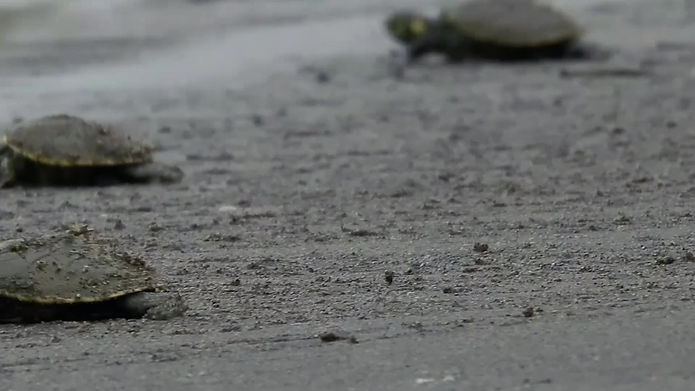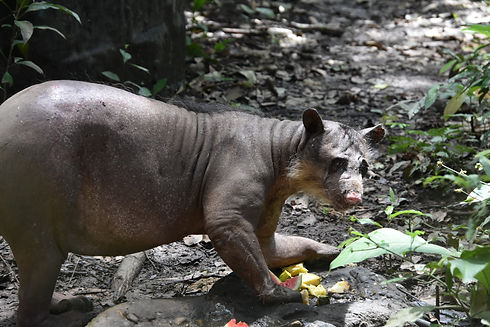

our
projects

spidermonkey
conservation
The Black Spider Monkey is a species which is extinct in the region of the lower Madre de Dios River in Puerto Maldonado. This local extinction is due mostly to strong anthropic pressures in the past (hunting, loss and disturbance of habitat). But since 2011 a population has been re-established in the area, and it is currently stable and growing. This is thanks to the efforts of the Taricaya Wildlife Rescue Centre, the support of government entities (Tambopata National Reserve and wildlife authorities of Madre de Dios) and Kawsay Biological Station.
Unfortunately there are still many young, orphaned or injured spider monkeys arriving at the rescue centre all the time, meaning that the human pressure in other parts of the Madre de Dios region is still very strong. We need your help to continue our work, to be able to give these animals the opportunity to return to the forest which they should never have been removed from. Our goal is to re-establish this species on the right bank of the lower Madre de Dios River. For this we offer a unique experience where you can participate in all stages of the process, from rehabilitation of the young animals to the monitoring of the released monkeys, and you can learn about two organisations and their professional staff who work directly together to ensure the survival of this incredible species.

rescue
center
Taricaya Research Center started working towards wildlife conservation since its foundation and was officially recognized by the government as a Wildlife rescue center in 2008. We were one of the first centers putting into practice wildlife release. In Peru most rescued animals had a zoo as their final destination. Our aims:
-
Rescue wild animals that were taken out of the rainforest to be kept in captivity.
-
Rehabilitate each animal to give them back their physical and emotional health.
-
Release the animals that recover their natural abilities for life in the wild.
-
Keep and give a good quality of life in captivity to the animals that cannot be released.
-
Monitor the animals after release to assess their adaptation into the wild.
-
Develop laboratory and field research in wildlife studies.
-
As an official institution for wildlife conservation in situ we have authorized programs for management, treatment, captive breeding, repopulation and reintroduction of wildlife.
-
Educate and create project awareness to involve more people in wildlife protection and/or to replicate this project, either independently or with our help to expand our area of influence.

turtle
project
The Yellow-spotted river turtle (Podocnemis unifilis) is rapidly disappearing from the rivers of the Amazon Basin due to poaching and other human activities that destroy their ecosystem. In 2005 Taricaya was awarded custody from the government of a river island about 1.5km from the reserve known to be a nesting spot for this river turtle during the dry season. We employed the help of an Ese-Eja native as our guide to monitor and protect the beaches of the island from poachers and our resident biologist set the methods for collection and relocation of the eggs in artificial beaches and release of the baby turtles when born. Aims:
-
Work towards the conservation of the endangered Taricaya river turtle.
-
Collect nests of the Taricaya turtle to save them from poachers and relocate them in artificial beaches at the reserve.
-
Repopulate the Madre de Dios river with baby turtles born from the artificial beaches.
-
Monitor our methodology to improve survival rate of the babies and study the species to learn more about its biology and behavior.
-
Educate and create project awareness to convince more people to replicate this project, either independently or with our help to expand our area of influence.

agro
forestry
Aware that migratory agriculture is one of the main threats to the rainforest, Taricaya created in 2004 the Pilot Farm to perform various experiments on polycultures and their productivity in one area at different times of the year. At the beginning, this model included livestock (goat, chickens and guinea pigs – a delicacy in Peru). Animals were eventually passed on to local communities. Whilst working with traditional crops, new combinations were planted, with tropical fruits and flowers, that produce short term and saplings of timber species of trees and the concept of the agroforestry system was put to the test. Since then growth and productivity of the Pilot Farm has been constantly monitored to determine its ecological and economic value and prove that the model can be advantageous as an alternative land use for a family´s livelihood and for reforestation.
Our aims:
-
Develop new techniques for agriculture and reforestation designed for local families to recover their abandoned plots with plants and timber that will provide them with a better income.
-
Regenerate and reforest areas of land into productive and valuable forests.
-
Promote effective and more sustainable alternatives for land users in the region.
-
Educate and create project awareness to convince more people to replicate this project, either independently or with our help to expand our area of influence.

butterfly
house
The mounting and sale of butterflies from the Amazon as decoration items or souvenirs for tourists can be a profitable business but unfortunately in most cases the specimens come from illegal extraction from the rainforest endangering native populations of these animals. In 2012, we built a Butterfly House with the idea of studying the life cycle of butterfly species to assess the possibility of in situ captive breeding as an economic option for local families through the legal sale of the off spring in the local markets. Our main species of interest has been the Owl butterfly, Caligo Oedipus. We capture individuals from the wild and set them inside the butterfly house providing the adequate habitat for their natural behavior to develop. To improve the survival rate, once they start to breed and caterpillars are born, we keep them separately to avoid competition and then care for the chrysalides until their birth into butterflies. We were able to establish a successful technique for their reproduction and this can be an alternative activity for extra income for a local family but it takes dedication. We must learn more about the diversity of Lepidoptera (butterflies and moths) in our area and not just focus on this one species; we also capture others to study their life cycle and captive breeding possibilities as a sustainable option for their conservation.

MahoganyProject
Mahogany, Swietenia macrophylla, is an important emergent tree of the rainforest that is now almost extinct outside protected areas due to overexploitation for timber. In 2004, Taricaya started a study to develop a new strategy for commercial plantations under the Agroforestry system. The project was developed from the beginning with the planting of seeds carefully managed to seedlings in the Nursery. We created the Mahogany workshop with lathes and other tools to produce bits of furniture, lamp stands etc. with the wood of young trees. In 2011, a forestry evaluation was done to determine the wood production and profitability of the plantation. Results proved that it is a financially viable option for farmers who can make money from reforestation at short-term whilst waiting for the big pay out of fully grown mahogany trees. Aims:
-
Innovate with new or not typical techniques to prove that commercial plantations of high-quality timber are not only possible, but profitable, to reduce the pressure on the forest.
-
Recover the soil and reforest abandoned farm plots for rainforest conservation
-
Educate and create project awareness to convince more people to replicate this project, either independently or with our help to expand our area of influence.
-
Explore the use of other tree species not commonly used as wood products to reduce pressure on overharvested species for commercial timber.










